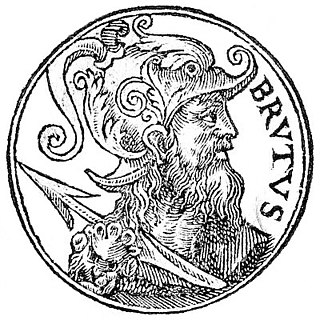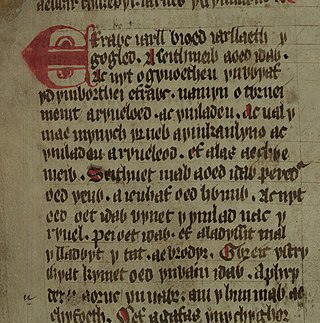Related Research Articles

Uther Pendragon (Brittonic), also known as King Uther, was a legendary King of the Britons and father of King Arthur.

Brutus, also called Brute of Troy, is a mythical British king. He is described as a legendary descendant of the Trojan hero Aeneas, known in medieval British legend as the eponymous founder and first king of Britain. This legend first appears in the Historia Brittonum, an anonymous 9th-century historical compilation to which commentary was added by Nennius, but is best known from the account given by the 12th-century chronicler Geoffrey of Monmouth in his Historia Regum Britanniae.

Cadwallon ap Cadfan was the King of Gwynedd from around 625 until his death in battle. The son and successor of Cadfan ap Iago, he is best remembered as the King of the Britons who invaded and conquered Northumbria, defeating and killing its king, Edwin, prior to his own death in battle against Oswald of Bernicia. His conquest of Northumbria, which he held for a year or two after Edwin died, made him one of the last recorded Celtic Britons to hold substantial territory in eastern Britain until the rise of the Welsh House of Tudor. He was thereafter remembered as a national hero by the Britons and as a tyrant by the Anglo-Saxons of Northumbria.
Mempricius was a legendary king of the Britons, as recounted by Geoffrey of Monmouth. He came to power in 1060BC. He was the son of King Maddan, brother of Malin, and father of king Ebraucus.

Leir was a legendary king of the Britons whose story was recounted by Geoffrey of Monmouth in his pseudohistorical 12th-century History of the Kings of Britain. According to Geoffrey's genealogy of the British dynasty, Leir reigned around the 8th century BC, around the time of the founding of Rome. The story was modified and retold by William Shakespeare in his Jacobean tragedy King Lear.
Cunedagius was a legendary king of the Britons, as recounted by Geoffrey of Monmouth. He came to power in 850BC.
Archgallo was a legendary king of the Britons as recounted by Geoffrey of Monmouth. He ruled from 339BC. He was the second son of King Morvidus and brother of Gorbonianus.
Ingenius is a legendary king of the Britons as recounted by Geoffrey of Monmouth's pseudohistorical work Historia Regum Britanniae, written c. 1138 CE. Ingenius was the fourth son of King Morvidus and the brother of Gorbonianus, Archgallo, Elidurus, and Peredurus. He came to power in 317BC.
Elidurus the Dutiful was a legendary king of the Britons as recounted by Geoffrey of Monmouth. He reigned in the late fourth century BC. He was the third son of King Morvidus and brother of Gorbonianus, Archgallo, Ingenius, and Peredurus.
Idvallo was a legendary king of the Britons as recounted by Geoffrey of Monmouth. He came to power in 287BC.

Historia regum Britanniae, originally called De gestis Britonum, is a pseudohistorical account of British history, written around 1136 by Geoffrey of Monmouth. It chronicles the lives of the kings of the Britons over the course of two thousand years, beginning with the Trojans founding the British nation and continuing until the Anglo-Saxons assumed control of much of Britain around the 7th century. It is one of the central pieces of the Matter of Britain.
Arvirargus or Arviragus was a legendary British king of the 1st century AD, possibly based upon a real person. A shadowy historical Arviragus is known only from a cryptic reference in a satirical poem by Juvenal, in which a giant turbot presented to the Roman emperor Domitian is said to be an omen that "you will capture some king, or Arviragus will fall from his British chariot-pole".
Eudaf Hen is a figure of Welsh tradition. He is remembered as a King of the Britons and the father of Elen Luyddog and Conan Meriadoc in sources such as the Welsh prose tale The Dream of Macsen Wledig and Geoffrey of Monmouth's Latin chronicle Historia Regum Britanniae. He also figures into Welsh genealogies. Geoffrey of Monmouth calls him Octavius, a corruption and faux-Latinization of Old Welsh/Breton Outham. According to the medieval Welsh genealogy from Mostyn MS. 117, Eudaf was a direct ancestor of King Arthur.

Peredur is the name of a number of men from the boundaries of history and legend in sub-Roman Britain. The Peredur who is most familiar to a modern audience is the character who made his entrance as a knight in the Arthurian world of Middle Welsh prose literature.
Gorbonianus was a legendary king of the Britons as recounted by Geoffrey of Monmouth. He came to power in 349BC. He was the eldest son of King Morvidus, and the brother of Archgallo, Elidurus, Ingenius, and Peredurus.

Welsh mythology consists of both folk traditions developed in Wales, and traditions developed by the Celtic Britons elsewhere before the end of the first millennium. As in most of the predominantly oral societies Celtic mythology and history were recorded orally by specialists such as druids. This oral record has been lost or altered as a result of outside contact and invasion over the years. Much of this altered mythology and history is preserved in medieval Welsh manuscripts, which include the Red Book of Hergest, the White Book of Rhydderch, the Book of Aneirin and the Book of Taliesin. Other works connected to Welsh mythology include the ninth-century Latin historical compilation Historia Brittonum and Geoffrey of Monmouth's twelfth-century Latin chronicle Historia Regum Britanniae, as well as later folklore, such as the materials collected in The Welsh Fairy Book by William Jenkyn Thomas (1908).
The Treason of the Long Knives is an account of a massacre of British Celtic chieftains by Anglo-Saxon soldiers at a peace conference on Salisbury Plain in the 5th century. The story is thought to be pseudohistorical as the only surviving records mentioning it are centuries later in the semi-mythological histories of the Historia Brittonum and the Historia Regum Britanniae. Though a popular cautionary tale in medieval Europe, there is no other historical evidence for The Treason of the Long Knives. Most historians interpret the story as a purely literary construction.
Mandubracius or Mandubratius was a king of the Trinovantes of south-eastern Britain in the 1st century BC.

King Hoel, also known as Sir Howel, Saint Hywel and Hywel the Great, was a late 5th- and early 6th-century member of the ruling dynasty of Cornouaille. He may have ruled Cornouaille jointly after the restoration of his father, Budic II of Brittany, but he seems to have predeceased his father and left his young son, Tewdwr, as Budic's heir.
Gwenddoleu ap Ceidio or Gwenddolau was a Brythonic king who ruled in Arfderydd. This is in what is now south-west Scotland and north-west England in the area around Hadrian's Wall and Carlisle during the sub-Roman period in Britain. Carwinley near Longtown north of Carlisle possibly derives from Cumbric Caer Wenddolau or Gwenddolau's Fort. The earthworks at Liddel Strength is also another contender for Caer Wenddolau.
References
- 1 2 "National Library of Wales, Welsh Classical Dictionary, page 615" (PDF). Retrieved 2024-09-06.
- ↑ Monarchie Nobelesse website, Bretons
- ↑ Sacred Texts website Histories of the Kings of Britain (Book II), by Geoffry of Monmouth, tr. by Sebastian Evans (1904)